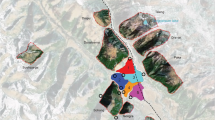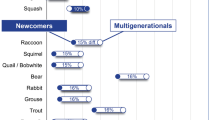Abstract
We expose some representations and practices related to the natural environment among Nahua peasants in a village located at the western boundary of Puebla and Guerrero states, in Mexico. Information was obtained by individual interviews and focal groups' work, following an open guide with ecological items considered as rooted in Mesoamerican cultures. The use of some local, vegetal resources, and the local perception of changes, mainly in the water availability, is documented. Survival strategies involve ancestral representations and material products, and entail a high grade of pragmatism. “Natural environment” is framed in a local culture that involves relational and sacred dimensions, usually omitted in other approaches. Hence, for the Temalac peasants, there is no dissection, at an operative level, between “natural facts” (for instance, water availability) and personal or social ones, being these often considered as determinant for the quality and accessibility of resources and weather conditions. We discuss the challenge for these elements posed by a growing migration rate and an increasing external influence.
Similar content being viewed by others
References
Bajtín, M. M. (1986). Problemas de la poética de Dostoievski. Mexico City: Fondo de Cultura Económica.
Batalla de Rodríguez, M. A. (1942). “Estudio de las plantas cultivadas en la región de IzÚcar de Matamoros, Pue.” Anales del Instituto de Biología 13: 463–489.
Bateson, G. (1979). Mind and Nature. A Necessary Unity. New York: E. P. Dutton.
De la Serna, J. (1953 [1892]). Manual de ministros de indios para el conocimiento de sus idolatrías, y la extirpación de ellas. México: Ediciones Fuente Cultural.
Desai, B. (1992). “Threats to the world eco-system: A role for the social scientists.” Social Science and Medicine 35(4): 589–596.
Florescano, E. (1999). Memoria Indígena. México City: Editorial Taurus.
Hendriks Pérez, P. S. (1945). Por tierras ignotas. Viajes y observaciones en la región del río de las Balsas. Mexico City: Editorial Cultura.
Hersch-Martínez, P. (1995). “Tlazol, ixtlazol y tzipinación de heridas: implicaciones actuales de un complejo patológico prehispánico.” Dimensión Antropológica 2(3): 27–59.
Hersch-Martínez, P. (1996). Destino comÚn: los recolectores y su flora medicinal. Mexico City: Instituto Nacional de Antropología e Historia.
Hersch-Martínez, P., M. M. González, and A. F. Alvarez (1999). “Acacia acatlensis: An alimentary resource in Southwest Puebla and North of Guerrero, Mexico.” Economic Botany 53(4): 448–450.
INEGI (Instituto Nacional de Estadística, Geografía e Informática) (1994). Censo General de Población. Mexico City: Instituto Nacional de Estadística, Geografía e Informática.
Katz, E. (1997). “Ritos, representaciones y meteorología.” InM. Goloubinoff, E. Katz and A. Lammel (eds.), Antropología del clima en el mundo hispanoamericano. Tomo II. (pp. 99–134). Quito: Ediciones Abya-Yala.
Kirchoff, P. (1943). “Mesoamérica: sus límites geográficos, composición étnica y caracteres culturales.” Acta Americana 1: 92–107.
Latour, B. (1991). Nous n'avons jamais eté modernes. Paris: Éditions La Découverte.
Martínez, M. (1928). Las plantas más Útiles que existen en la RepÚblica Mexicana (pp. 342–346). Mexico City: Talleres Litográficos de H. Barrales Sucr.
Matías Alonso, M. (ed.) (1994). Rituales agrícolas y otras costumbres guerrerenses. Mexico City: Centro de Investigaciones y Estudios Superiores en Antropología Social.
Matías Alonso, M. (1997). La agricultura indígena en la montaña de Guerrero. Mexico City: Plaza y Valdés.
Miranda, F. (1942). “Estudios sobre la vegetación de México. III.” Anales del Instituto de Biología 13: 417–450.
Palerm, A. (1972). Agricultura y Civilización en Mesoamérica. Mexico City: Secretaría de Educación PÚblica.
Rivera Morales, I. and F. Miranda (1942). “Nombres vulgares de plantas en el S.O. del Estado de Puebla.” Anales del Instituto de Biología 13: 493–498.
Robichaux, D. (1997). “Clima y continuidad en las creencias prehispánicas en la región de La Malinche (México).” In M. Goloubinoff, E. Katz, and A. Lammel (eds.), Antropología del clima en el mundo hispanoamericano. Tomo II. (pp. 7–30). Quito, Ecuador: Ediciones Abya-Yala.
Rojas Rabiela, T. (1988). Las siembras de ayer. La agricultura indígena del siglo XVI. México City: Secretaría de Educación PÚblica y Centro de Investigaciones y Estudios Superiores en Antropología Social.
Ruiz de Alarcón, H. (1988 [1629]). Tratado de las supersticiones y costumbres gentílicas que hoy viven entre los indios naturales desta Nueva España. Edited by M. E. Garza. México City: Secretaría de Educación PÚblica.
Rzedowski, J. (1998). “Diversidad y orígenes de la flora fanerogámica de México.” In T. P. Ramamoorty, R. Bye, A. Lot, and J. Fa (eds.), Diversidad Biológica de México (pp. 129–145). México City: Instituto de Biología, Universidad Nacional Autónoma de México.
SahagÚn, B. (1988). Edited by J. García Quintana and A. López Austin. Mexico City: Consejo Nacional para la Cultura y las Artes.
Silvestri, A. and G. Blanck (1993). Bajtín y Vogotski: la organización semiótica de la conciencia. Barcelona: Anthropos.
Toledo, V. M. (1992). “What is etnoecology? Origins, scope and implications of a rising discipline.” Etnoecologica 1(1): 5–21.
Toledo, V. M., B. Ortiz, and S. M. Morales (1994). “Biodiversity islands in a sea of pasturelands: Indigenous resource management in the humid tropics of Mexico.” Etnoecológica 2(3): 37–49.
Villela, S. (1995). “Los Nahuas de Guerrero.” In Etnografía Contemporánea de los Pueblos Indígenas de México. Región Pacífico Sur. México City: Instituto Nacional Indigenista.
Zimmerman, M. E. (1994). Contesting Earth's Future. Radical Ecology and Postmodernity. Berkeley: University of California Press.
Author information
Authors and Affiliations
Corresponding author
Rights and permissions
About this article
Cite this article
Hersch-Martínez, P., González-Chévez, L. & Alvarez, A.F. Endogenous knowledge and practice regarding the environment in a Nahua community in Mexico. Agriculture and Human Values 21, 127–137 (2004). https://doi.org/10.1023/B:AHUM.0000029404.34942.d1
Issue Date:
DOI: https://doi.org/10.1023/B:AHUM.0000029404.34942.d1




